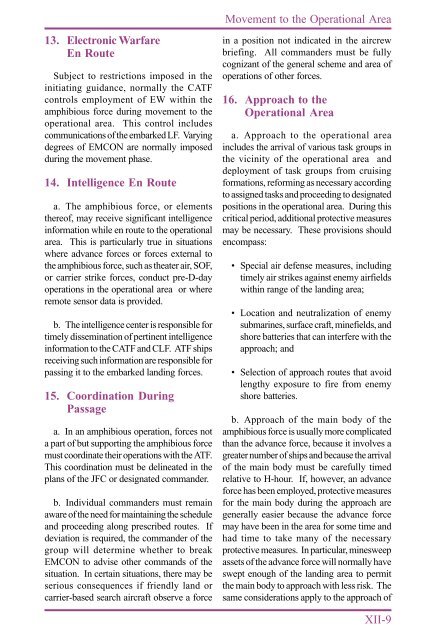Joint Doctrine for Amphibious Operations - Historic Naval Ships ...
Joint Doctrine for Amphibious Operations - Historic Naval Ships ...
Joint Doctrine for Amphibious Operations - Historic Naval Ships ...
- No tags were found...
Create successful ePaper yourself
Turn your PDF publications into a flip-book with our unique Google optimized e-Paper software.
13. Electronic WarfareEn RouteSubject to restrictions imposed in theinitiating guidance, normally the CATFcontrols employment of EW within theamphibious <strong>for</strong>ce during movement to theoperational area. This control includescommunications of the embarked LF. Varyingdegrees of EMCON are normally imposedduring the movement phase.14. Intelligence En Routea. The amphibious <strong>for</strong>ce, or elementsthereof, may receive significant intelligencein<strong>for</strong>mation while en route to the operationalarea. This is particularly true in situationswhere advance <strong>for</strong>ces or <strong>for</strong>ces external tothe amphibious <strong>for</strong>ce, such as theater air, SOF,or carrier strike <strong>for</strong>ces, conduct pre-D-dayoperations in the operational area or whereremote sensor data is provided.b. The intelligence center is responsible <strong>for</strong>timely dissemination of pertinent intelligencein<strong>for</strong>mation to the CATF and CLF. ATF shipsreceiving such in<strong>for</strong>mation are responsible <strong>for</strong>passing it to the embarked landing <strong>for</strong>ces.15. Coordination DuringPassagea. In an amphibious operation, <strong>for</strong>ces nota part of but supporting the amphibious <strong>for</strong>cemust coordinate their operations with the ATF.This coordination must be delineated in theplans of the JFC or designated commander.b. Individual commanders must remainaware of the need <strong>for</strong> maintaining the scheduleand proceeding along prescribed routes. Ifdeviation is required, the commander of thegroup will determine whether to breakEMCON to advise other commands of thesituation. In certain situations, there may beserious consequences if friendly land orcarrier-based search aircraft observe a <strong>for</strong>ceMovement to the Operational Areain a position not indicated in the aircrewbriefing. All commanders must be fullycognizant of the general scheme and area ofoperations of other <strong>for</strong>ces.16. Approach to theOperational Areaa. Approach to the operational areaincludes the arrival of various task groups inthe vicinity of the operational area anddeployment of task groups from cruising<strong>for</strong>mations, re<strong>for</strong>ming as necessary accordingto assigned tasks and proceeding to designatedpositions in the operational area. During thiscritical period, additional protective measuresmay be necessary. These provisions shouldencompass:• Special air defense measures, includingtimely air strikes against enemy airfieldswithin range of the landing area;• Location and neutralization of enemysubmarines, surface craft, minefields, andshore batteries that can interfere with theapproach; and• Selection of approach routes that avoidlengthy exposure to fire from enemyshore batteries.b. Approach of the main body of theamphibious <strong>for</strong>ce is usually more complicatedthan the advance <strong>for</strong>ce, because it involves agreater number of ships and because the arrivalof the main body must be carefully timedrelative to H-hour. If, however, an advance<strong>for</strong>ce has been employed, protective measures<strong>for</strong> the main body during the approach aregenerally easier because the advance <strong>for</strong>cemay have been in the area <strong>for</strong> some time andhad time to take many of the necessaryprotective measures. In particular, minesweepassets of the advance <strong>for</strong>ce will normally haveswept enough of the landing area to permitthe main body to approach with less risk. Thesame considerations apply to the approach ofXII-9
















